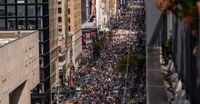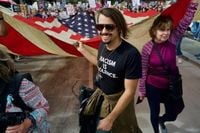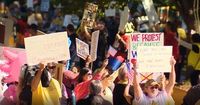On October 18, 2025, a wave of protest swept across the United States, drawing millions into the streets under the banner of the "No Kings" movement. From the Bay Area to Pennsylvania, and in major cities like New York, Chicago, Washington DC, and Los Angeles, demonstrators gathered to voice their opposition to President Donald Trump's administration and what they see as his unprecedented use of presidential power. The turnout, by all accounts, was massive—organizers claimed as many as 7 million participants nationwide, making it one of the largest coordinated protest actions in recent American history, according to the Pennsylvania Capital-Star and BBC.
At the heart of these demonstrations were young people, whose energy and optimism fueled the movement. In the Bay Area, crowds marched and rallied, driven by what Melissa Micheleson, a political science professor and Dean of Arts and Sciences at Menlo College, described as a belief in the power of sustained social movements. "We have seen in the past that sustained social movement does generate change. It doesn't work every time. It's really hard. It takes a long time," Micheleson told ABC7 News. She emphasized the crucial next steps: "So part of it can be okay we've protested, but we're not done. And now you gotta you know, register to vote. Now you got to vote. Now you got to contact your members of Congress, whatever it is that in your state or city that folks want you to do, maybe you're going to take more action."
In Pennsylvania, the dissent was palpable as tens of thousands gathered in cities and towns across the state. Between 5,000 and 6,000 people rallied outside the state Capitol in Harrisburg, while an estimated 20,000 marched through Philadelphia, ending at Independence Hall—a symbolic location where the nation’s founding documents were first debated and adopted. The air was festive, but the message was grave. Tracie Benner, 61, of Juniata County, captured the sentiment: "People fought and died for us to have the rights we have. And now for Trump and the Supreme Court and the Congress to just throw it away, we won’t stand for that." (Pennsylvania Capital-Star)
Organizers and participants alike stressed the importance of unity and visibility. Stephanie Vincent, a lead organizer with Community Change for Montgomery County, noted, "A big part of these kinds of protests is just people realizing that they’re not alone. That there are other people that think like they do and care about the things that they care about." This sense of solidarity was echoed by Justin Douglas, a Democratic Dauphin County Commissioner, who told a Hershey crowd, "We need moments like this right here where we’re out of social media, we’re in the real world, we’re standing in a park together in our community."
Protesters found creative ways to keep the atmosphere light and inclusive, even as they addressed weighty topics. Across Pennsylvania and beyond, people donned inflatable dinosaur, cow, shark, and axolotl costumes—a deliberate effort to diffuse tension and draw attention to violent police tactics used elsewhere. Amy, dressed in a pink axolotl costume, explained to the Pennsylvania Capital-Star, "Honestly, it just feels very American to me. We’re just such a serious bunch, you know? We try our best to just fight for our rights and everything, but we still know how to have fun."
The protests were not confined to left-leaning cities. Demonstrations took place in deep red Butler County and hundreds of smaller towns, reflecting a broad coalition of Democrats, liberals, and some anti-Trump Republicans. Many participants were first-time protesters, drawn by concerns over what they saw as the erosion of American democratic norms. Don Coleman, 69, summed up the generational stakes: "My father was a veteran after World War II. My grandfather fought in World War I. I have friends who fought in Vietnam. How did we get here? They didn’t fight for this."
In Washington DC, the rally took on a distinctly national character. Senator Chris Murphy of Connecticut addressed a jubilant crowd: "Today all across America in numbers that may eclipse any day of protest in our nation's history, Americans are saying loudly and proudly that we are a free people, we are not a people that can be ruled, our government is not for sale." (BBC) The peaceful, family-friendly atmosphere in the nation’s capital stood in sharp contrast to the warnings from some Congressional Republicans, who had labeled the demonstrations "anti-American" and put the National Guard on alert. Yet, in New York City, not a single protest-related arrest was reported, and the mood remained festive.
The Trump administration, for its part, responded with derision. Deputy press secretary Abigail Jackson dismissed media queries with a curt "Who cares," while President Trump posted AI-generated videos on his Truth Social website, mocking the protesters by depicting himself wearing a crown and dumping waste on the crowds below. These responses only seemed to galvanize the opposition further, underscoring the deep divisions in American political life.
The underlying grievances fueling the protests were varied. Many cited Trump’s aggressive immigration enforcement, government cuts, deployment of the National Guard in US cities, and what they saw as a norm-breaking use of presidential authority. Others pointed to the conservative Supreme Court majority, secured by Trump’s three first-term appointments, which has allowed administration policies to move forward through its shadow docket. The ongoing government shutdown—now entering its fourth week—added urgency, with federal workers missing paychecks and critical social programs facing funding shortfalls. According to BBC, Democratic leaders have resisted approving a short-term extension of federal spending without bipartisan agreement, seeking to protect health-insurance subsidies for low-income Americans.
Yet, the protests also revealed cracks within the Democratic coalition. Some marchers expressed frustration with party leaders, criticizing what they saw as a lack of assertiveness. "We're just taking it on the chin, and we're not speaking out. You know, I think we need to throw some more elbows. Unfortunately, the high road doesn't work," one attendee told NBC News. Disagreements over strategy—whether to focus on economic issues or social policies—have led to contentious primary battles in states like Maine, Massachusetts, California, and Michigan, pitting establishment figures against younger, more liberal candidates.
Looking ahead, the question remains whether the energy of the "No Kings" movement will translate into electoral gains. November’s gubernatorial elections in Virginia and New Jersey are seen as early tests. At a rally in Montclair, New Jersey, Democratic National Committee Chair Ken Martin urged the crowd, "It is one thing to show up at these protests. And it's another to move the needle and get back some power." The real test, however, will come in the 2026 midterms, when control of Congress is up for grabs and the possibility of checking Trump’s power becomes tangible.
In the end, the "No Kings" protests were a striking display of democratic engagement—peaceful, passionate, and diverse. Whether this moment of unity and resistance can be sustained, and whether it will reshape the political landscape, remains to be seen. For now, millions have made it clear: they are not content to be ruled.


